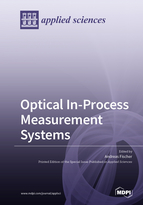Optical In-Process Measurement Systems
A special issue of Applied Sciences (ISSN 2076-3417). This special issue belongs to the section "Optics and Lasers".
Deadline for manuscript submissions: closed (1 January 2022) | Viewed by 24987
Special Issue Editor
Special Issue Information
Dear Colleagues,
Optical principles enable precise measurements down to the quantum mechanical limits and provide the fastest possible measurement speed, which is the speed of light. Driven by the ongoing advances in powerful light sources, accurate light modulation possibilities, and efficient light detectors, the capabilities of optical measurement systems are increasing. However, a current challenge is to make use of the benefits of optical principles for in-process measurements on real-world objects. Examples are flow processes on wind turbines, on airplanes, and in combustors, thermal and mechanical processes on a workpiece during manufacturing, and the exploration of natural processes on Earth and in space. Studying non-idealized, non-scaled objects during their actual operation is an important task for the measurement science, since it allows us to gain new insights from the actual process behavior to be engineered. Furthermore, in-process measurements are required to create in-process controls. In-process measurement conditions are often challenging and can mean a limited optical access, an uncooperative measurement environment, a large measurement distance, a large measurement object, or just a low signal-to-noise ratio. In order to break new ground for the transition “from the lab to the app” (from the laboratory to the application), optical in-process measurements have to be realized at the limits of measurability and beyond.
We are therefore interested in articles that investigate in-process measurements by means of optical principles (VIS, IR, UV). Potential topics include, but are not limited to, the following:
- innovative measurement principles using visible, infrared, or ultraviolet light;
- model-based measurement approaches and/or data fusion that enable new measurands;
- scaling of the measurement range from the lab to the app;
- knowledge extraction from less-reproducible in-process measurement conditions;
- fast measurements using scanning and multiplexing techniques;
- measurement systems with adaptive components;
- investigation and correction of cross-sensitivities;
- limits of measurability by studying the minimal achievable measurement uncertainty;
- novel findings about the investigated process due to in-process measurements;
- application case studies;
- applicability of a single measurement principle for different in-process applications and vice versa.
Original work highlighting the latest research and technical development is encouraged, but review papers and comparative studies are also welcome.
Prof. Andreas Fischer
Guest Editor
Manuscript Submission Information
Manuscripts should be submitted online at www.mdpi.com by registering and logging in to this website. Once you are registered, click here to go to the submission form. Manuscripts can be submitted until the deadline. All submissions that pass pre-check are peer-reviewed. Accepted papers will be published continuously in the journal (as soon as accepted) and will be listed together on the special issue website. Research articles, review articles as well as short communications are invited. For planned papers, a title and short abstract (about 100 words) can be sent to the Editorial Office for announcement on this website.
Submitted manuscripts should not have been published previously, nor be under consideration for publication elsewhere (except conference proceedings papers). All manuscripts are thoroughly refereed through a single-blind peer-review process. A guide for authors and other relevant information for submission of manuscripts is available on the Instructions for Authors page. Applied Sciences is an international peer-reviewed open access semimonthly journal published by MDPI.
Please visit the Instructions for Authors page before submitting a manuscript. The Article Processing Charge (APC) for publication in this open access journal is 2400 CHF (Swiss Francs). Submitted papers should be well formatted and use good English. Authors may use MDPI's English editing service prior to publication or during author revisions.
Keywords
- in-process measurement
- optical measurement principle (visible, infrared, ultraviolet)
- real-world object
- measurement system
- measurement uncertainty
- measurability






